28. INTO THE AGE OF TRUMP

AMERICA AND THE WORLD
CONTENTS
 Renegotiating NAFTA Renegotiating NAFTA
 Crisis in Central America Crisis in Central America
 Venezuela Venezuela
 Xi Jinping's China Xi Jinping's China
 Putin's Russia Putin's Russia
 The world of Islam The world of Islam
 The bizarre world of Kim Jung Un's The bizarre world of Kim Jung Un's
Korea
 Trump's relations with Europe Trump's relations with Europe
The textual material on this webpage is drawn directly from my work
America – The Covenant Nation © 2021, Volume Two, pages 465-475.
|
Meanwhile, life went on in the White House, as
America found itself grappling with typical international issues that
needed close attention.
At the end of November 2018, Trump, plus
leaders of Mexico and Canada, signed the United States-Mexico-Canada
Agreement (USMCA), replacing the North American Free Trade Agreement
(NAFTA) first negotiated during in the Bush, Sr. presidency and put
into force under the Clinton presidency. As with NAFTA, the USMCA was
designed to create "fair" trade operations among these three North
American countries.
Over time, commercial dynamics had
changed as the economies of the three countries developed. A big trade
imbalance in favor of Mexico was developing for America;
American-Canadian trade was more closely balanced, though even then
slightly in favor of Canada. A big issue was Mexico's VAT (Value Added
Tax), a European invention that encourages exports by taxing items only
when finally sold, unless the items are exported, and thus they become
untaxed. Thus American products headed to Mexico get taxed in America
at various stages of production, and then additionally by Mexico's VAT
of 16 percent rate, whereas Mexican products leaving the country do not
get taxed, a form of subsidy for Mexican exports. In addition to this
subsidy, cheap Mexican labor had drawn many American producers to
relocate their operations to Mexico for products ultimately headed to
America. This was costing America the loss of a huge number of jobs.
But of course, this had provided Mexico with much of its employment. But Trump wanted this renegotiated.
Other items were also renegotiated: the
auto trade (obviously Mexican-produced cars are much cheaper than
American-produced cars, mostly because of the difference in wage rates
and workers' benefits), but also intellectual property rights, and the
trade in vital goods such as farm and dairy products (actually highly
protected in the US), drugs, oil, steel, aluminum, lumber and raw
materials.
In order to get America's trade partners to act on these trade issues,
Trump had, soon after taking office as U.S. president, threatened to
pull America entirely out of NAFTA. To underscore his resolve to see
things renegotiated, he imposed new tariffs on Canadian and Mexican
steel and aluminum. Talks got underway, and went on for a year before
an agreeable settlement could be reached: the USMCA.
Trump was pleased with his negotiating success. But it raised questions
about the continuing availability of inexpensive cars from Mexico on
the American market, trade protections favoring certain American
producers usually always translating themselves into greater costs for
the American consumer. Ultimately a Democrat-controlled House dragged
its feet on approving the new trade agreement – finally at the very end
of 2019 coming to a compromise more favorable to American labor and
environmentalist groups, which then opened the possibility of
Congressional approval.
CRISIS IN CENTRAL AMERICA |
|
Another big problem hitting America at its borders
had long been the huge influx of Central Americans attempting to escape
the chaos of a collapsed social order in Guatemala, El Salvador and
Honduras. Thugs and gangs constituted whatever social order now existed
in these states, especially in Honduras. This urge to escape these
terrifying conditions was not new, but reached crisis proportions in
the early 2010s, only increasing in scope since then, as hundreds of
thousands of Central Americans streamed north through Mexico to get
across the quite porous national borders of America where, once inside,
they could disappear into the growing Latin-American community now
widespread across America. By the time of Trump's entry into the White
House whole caravans of tens of thousands of Central Americans were
filling the Mexican highways, headed to America.
Even in the days of his campaigning for
the presidency, Trump boasted about a wall he was going to build to
stop this ethnic invasion from Central America, and that Mexico was
going to pay for it! Nobody believed that was ever going to happen, but
it certainly made for much heated discussion. Ultimately, "Trump's
Wall" became (along with his impeachment) a subject of intense coverage
by the sensation-seeking media.
Actually, the issue was even more complex
in that these caravans headed for the U.S. included not only Central
Americans but Africans, Middle Easterners and others, with the same
goal of getting inside the US. And there were other motives mixed in
with the desperation to escape chaotic conditions in the refugees'
homelands: drug trafficking, children trafficking (having an
"accompanying child" was known to open the legal doors of American
access more easily), and the possibility that people bent on doing harm
to America (such as Islamic jihadists) became a matter of concern, a
concern that Trump emphasized at every opportunity.
He wanted this invasion of America to
stop. But this in turn brought out all the anti-Trump voices who
claimed that America was a "welcoming nation" and that even the idea of
the border itself was a cruel concept that needed to be ended – simply
ignoring the fact that the "cruelties" being committed by Trump in
blocking this flow of refugees to America were the very same activities
done under the laws and practices occurring during the Obama
presidency. But since it was Trump rather than Obama now standing
behind these same restrictions and procedures, all of this now was so
much more heartless and cruel.
Immigrants, as everyone well knows, tend
to support a party that will take care of them. And that was, after
all, the central agenda of the Democratic Party: to have Washington
take care of those who have become dependent on that care. It's a
semi-feudal political instinct that goes all the way back to the
regimes of the American urban bosses who did the same thing with
immigrant groups, notably the Irish and Southern Italians, who flooded
the country in the 1800s and early 1900s. Now it was the Hispanics turn
to see how that worked. And they were quite aware of the deal. That's
why they were heading north in such great numbers.
However, under the threat of more
restrictions on Mexican trade to America, the Mexican government agreed
finally (June 2019) to help slow up, with militarized police, the flow
of the caravans through Mexico, and to house some of the asylum seekers
while they awaited their claims as refugees to be processed by the US.
Actually, finding a solution to this
problem is of critical importance to America – not just because of the
huge number of individuals and families attempting to flee the
conditions there and find refuge in the US, but because it is America's
job still to stand as a light to and support of other societies on this
globe. That is the responsibility of a global superpower, especially a
Christian superpower.
Something like a Marshall Plan for the
crisis countries of Guatemala, El Salvador and especially Honduras
would be far more effective than merely building expensive walls to
keep the refugees out. Setting up job training and encouraging (even
partially subsidizing) American producers, who have been using low-cost
Chinese labor, to now work with Central American workers, would be a
big help to both U.S. industry and those Central American countries
suffering massive social collapse. It would require a lot of careful,
and expensive, investment. But so did the Marshall Plan, an outstanding
success and a wonderful thing that a Christian America did for the
world, even for its recent enemies.
|
Meanwhile, even further to the South, the
Venezuelan Socialist regime of Nicolás Maduro (taking over in 2013 at
the death of the originator of Venezuela's Cuba-like "Socialist
Revolution," Hugo Chavez) was finding itself presiding over a
collapsing economy, due in part to its program of heavy-handed – even
brutal – Socialism, but also worsened by America's (and others) 2017
embargo on Venezuelan exports, such as its rich supply in oil, and
imports such as food and medicine.
Potentially here too, hundreds of
thousands of Venezuelans would want to gain similar entry into America,
to escape the deplorable (even murderous) conditions that had come to
prevail in Venezuela. From 2015 to mid-2019 over 4 million Venezuelans,
or 12 percent of the population, escaped Venezuela, however mostly
heading to nearby South American countries or to the Caribbean islands,
and some, from there, onwards.
America (and its European allies) had
supported Maduro's opponent, Juan Guaidó, in the highly questionable
2018 elections under the new (pro-Maduro) Constitution. The situation
resulting from these elections had become so chaotic in Venezuela that
it was hard to distinguish the better from the worse. Predictably,
China, Russia, Cuba, Iran and Syria (but also Turkey?) came out in
strong support of Maduro's regime, which maintained a strong backing of
the Venezuelan army, and was thus not yet likely to be toppled, despite
Maduro's huge unpopularity among major sectors of the Venezuelan
population, and even despite American efforts to shut down the
Venezuelan economy.
|
While America had itself engaged morning, noon and
night, on one talk-show after another, debating the scandal of the
Trump-Russia connection, China was quietly advancing its political,
economic and diplomatic position around the globe. China, under its
potential President-for-Life, Xi Jinping,1
was moving ever forward in a grand effort to replace America as the
world's leading superpower – even the only superpower still standing
after America would take its inevitable fall, as had every other
Western superpower since the decline of Spain in the 1600s and 1700s
(even just in the 20th century alone: France, England, the Netherlands,
Russia, etc.)
This goal became quite clear back in 2015
when Xi announced a new Chinese 10-Year Plan, "Made in China 2025." The
heart of the Plan involved the development of a number of areas in the
realm of high-technology, economic realms which would receive a large
amount of government protection and support, designed to give China a
commanding position in the international technology market (robotics,
telecommunications, artificial intelligence or AI in a wide range of
fields, etc.), in the biomedical market, in industrial materials
development, and in the establishment of global purchasing and sales
networks.
The international strategy or game that
China played was a subtle one: avoid direct confrontation where
possible, but gradually (and quietly) take a vital position of control
here and there, in small bites, of course, so as not to spark a
reaction from America and the West at any particular point.2
Anyway, America had been so distracted
with events in the Middle East since the beginning of the 21st century
that it was not really paying attention to what was coming out of East
Asia. Bush, Jr. was so wrapped up in Afghanistan and Iraq that he had
no time to focus on developments in East Asia. And Obama thought he
could charm the world into niceness, failing to respond strongly to
challenges to America's vital points of placement on the global playing
field.
Also, it is important to note that China
alone mines most of the world market's "rare metals" vitally needed by
today's technology (such as cobalt), and a shutdown, or even slowdown,
would cripple the ability of the world beyond China to continue to
develop that technology. These metals are also found elsewhere outside
of China, though very expensive to process. It is a lot easier to
depend on the Chinese supply. And China, and the world, both know this.
Furthermore, the number of American (and
other Western) companies that depend on cheap Chinese labor to assemble
parts or even the whole of their products prior to market is incredibly
large. Thus now to find their products even marketable, they depend
entirely on their "China connection." Again, China – and the world –
are well aware of this growing dependency.
Also, in China companies such as Alibaba
and Tencent have moved to near monopolistic positions in a wide range
of areas (somewhat similar to Amazon in the way such companies control
financial transactions in a wide range of industries), including
purchases of companies abroad. This includes even American companies,
such as Alibaba's proposal to purchase the American company MoneyGram –
until the U.S. government's Committee on Foreign Investment in the U.S.
(CFIUS) stepped in to block the sale.
At the same time, China has long been
offering a lot of foreign aid to smaller countries. Multitudes of
Chinese technologists can be found all around the world, helping
smaller countries develop – using Chinese equipment and technology that
in the long run would make them China-dependent.
Also very importantly, China by 2019 was
offering the world the new 5G internet technology, the highly advanced
technology following up Huawei Technology's 4G telecommunications
network and consumer products sales, also strategically located
globally. Huawei offered top-level communications technology and
products at rock-bottom prices through Chinese government price support
(and research services support), putting this Chinese company at the
head and heart of the world telecommunications industry, by which the
world's commerce was managed. Just like the South China Sea naval-air
station, and the global rare-metals siting, this put China in the
position on its diplomatic game-board of full dominance.
To put this plan on a solid basis, in
April of 2019, Xi hosted an international gathering to discuss his
"Belt and Road" program, linking the Chinese economy with the economies
of other countries, even in Europe. Some 40 countries attended (America
did not attend, nor did China's chief rival in Asia, India).
Meanwhile, Trump had long been
complaining about the Chinese theft of American intellectual property
(critically important in the technology field), and the subsidizing of
their own Chinese companies in order to give them a competitive edge on
the world market, even in America (this certainly was the case with
Huawei products). Trump was also very upset at the way Chinese
companies had bought up American companies, quite notably in the
high-tech field (estimates ran to as much as $46 billion worth of
Chinese investment as of 2016), whereas the Chinese made foreign
investment in their country prohibitively difficult.
Thus Trump in March of 2018 invoked the 1974 Trade Act to block further
Chinese acquisition of American high-tech companies, also announcing
the imposing of new tariffs as of the beginning of 2019 on $250 billion
worth of Chinese goods seeking entry into the U.S. – tariffs doubling
from 10 percent to 25 percent of the value of these Chinese goods. Not
surprisingly, China retaliated with its announcement that it would be
imposing duties on $110 billion worth of American goods coming into
China. However, other countries joined America in also putting new
tariffs on Chinese goods. Finally, in December of 2018, just as the
tariffs were due to go into effect, the two sides decided to try to
negotiate some kind of compromise, especially as these tariffs hurt
both economies. They were proposing to arrive at an agreement by
mid-May of 2019. But ultimately even these efforts at a compromise
found the going so rough that nothing came of the negotiations. The
trade war thus merely deepened.
Anyway, trust in the actual enforcement
of any agreed-on terms by China remains a huge American concern, as the
Chinese have long been known to find clever ways of getting around the
rules of trade as set out by the World Trade Organization (WTO).
But America is not the only country
becoming very suspicious of Chinese economic programming. Australia
also has been the recipient of massive Chinese investment by way of the
purchasing of Australian companies in key fields. Finally in 2016, the
Australian government put up roadblocks preventing China from buying
up Australian companies in the key fields of agriculture and electric
power generation and supply. Germany and France have also become wary
about Chinese strategic investment, and the dumping of subsidized (and
thus cheaper) Chinese products on the European market, and have begun
to press the European Union to tighten up on Chinese economic activity
in Europe.
1In
March of 2018, the National People's Congress voted 2,964 to 2 to
remove the Constitution's two-term limits on the presidency – limits
observed since the reforms of Deng Xiaoping in the 1990s. This is quite
indicative of how Xi had eliminated the collective leadership of the
country in order to make himself the sole determiner of China's
policies and programs, something not seen in China since the days of
Mao Zedong but something that looked a bit like the situation still
going on in North Korea – where the Great Leader does the thinking for
all the people.
2Newt
Gingrich likened it to the difference between the West's most
sophisticated board game, chess, and the Chinese counterpart, Weiqi (or Go).
Chess is played by carefully moving particular pieces with varying
importance or power, focusing on throwing that weight at the two most
valuable of all pieces, the queen and then the king. But Weiqi is
played on a larger board with many, but equal, pieces – in which the
goal is simply to place each piece in a particular stationary position
on the board until one or the other of the adversaries finds itself so
surrounded that it cannot move another piece into place. Subtle, but an
effective path to victory. "China wants to replace America as THE
global superpower – Here's what we must learn," Fox News, April 25,
2019.
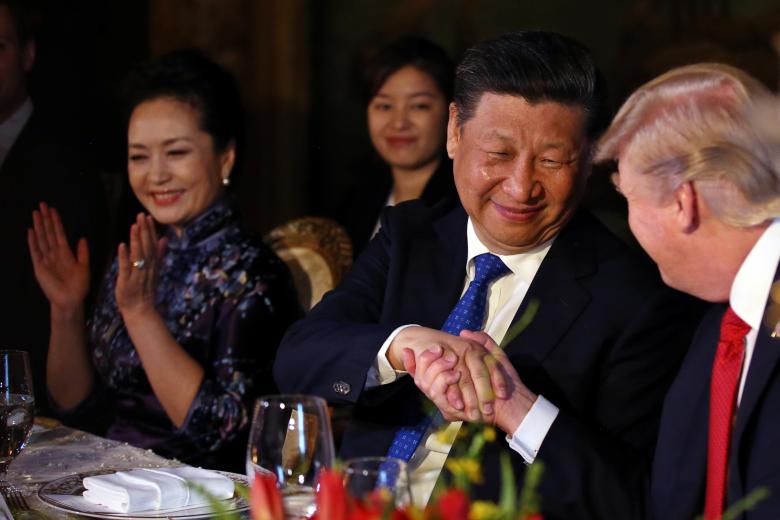
Trump dining with Chinese
Premier Xi Jinping at Mar-a-Logo – April 7, 2017
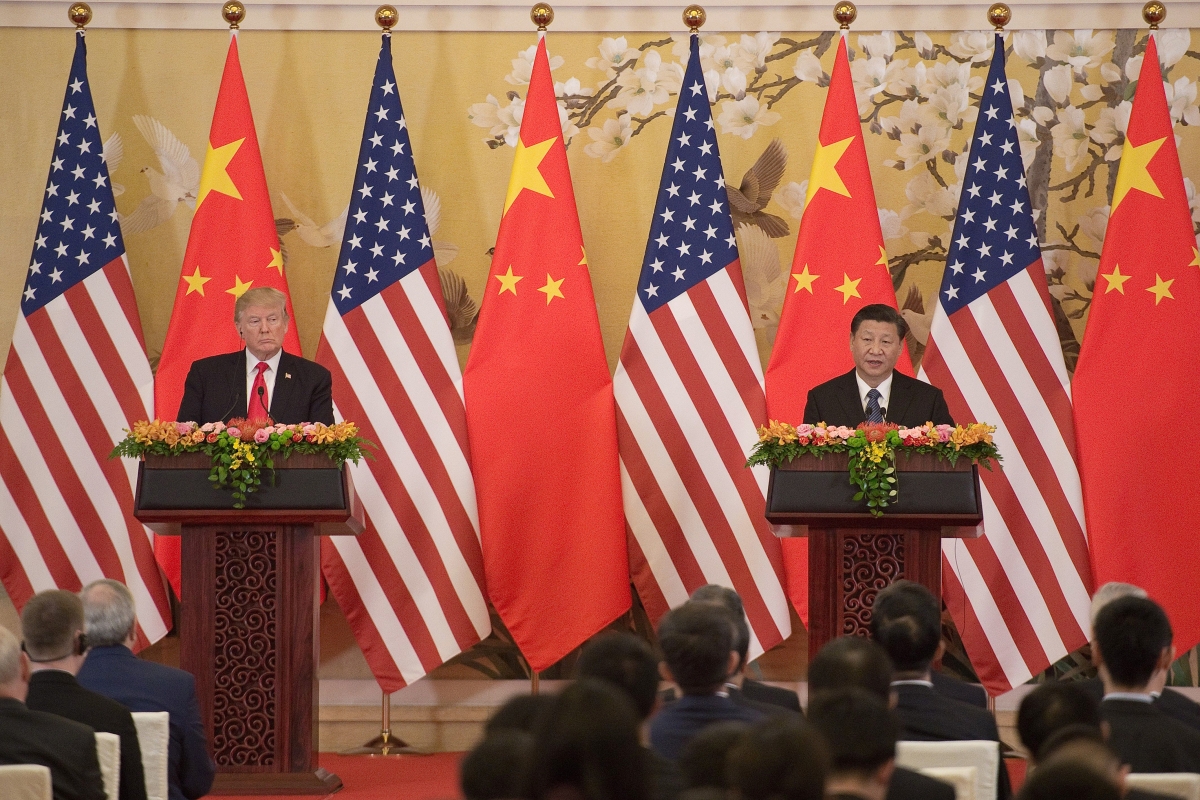
Trump and Xi in Beijing – November 9, 2017
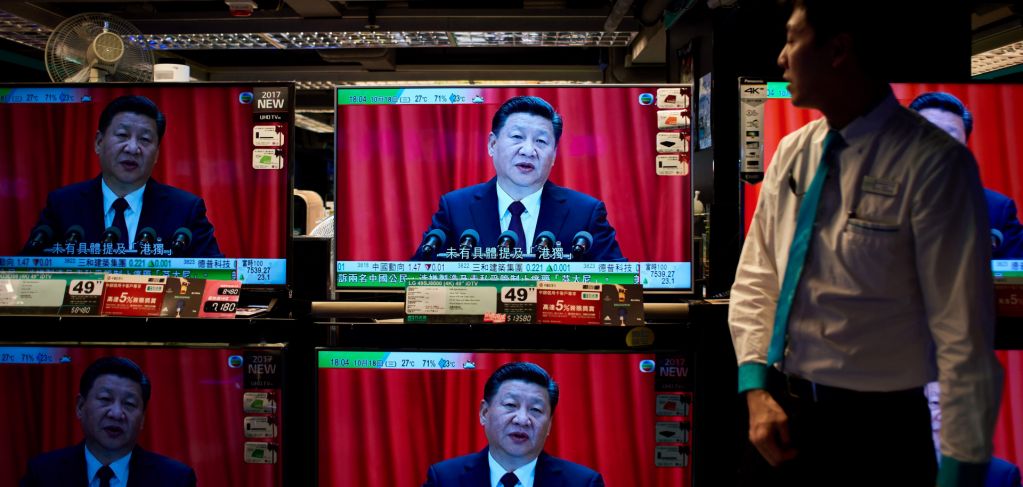
Televisions on display at an electronics store in Hong Kong are all tuned to
Chinese President
Xi Jinping's address to
the 19th Chinese Communist Party Congress
on Oct. 18, 2017 ...
explaining the directions China will be taking as
it elevates itself to the status of superpower
– (perhaps the world's
sole superpower).
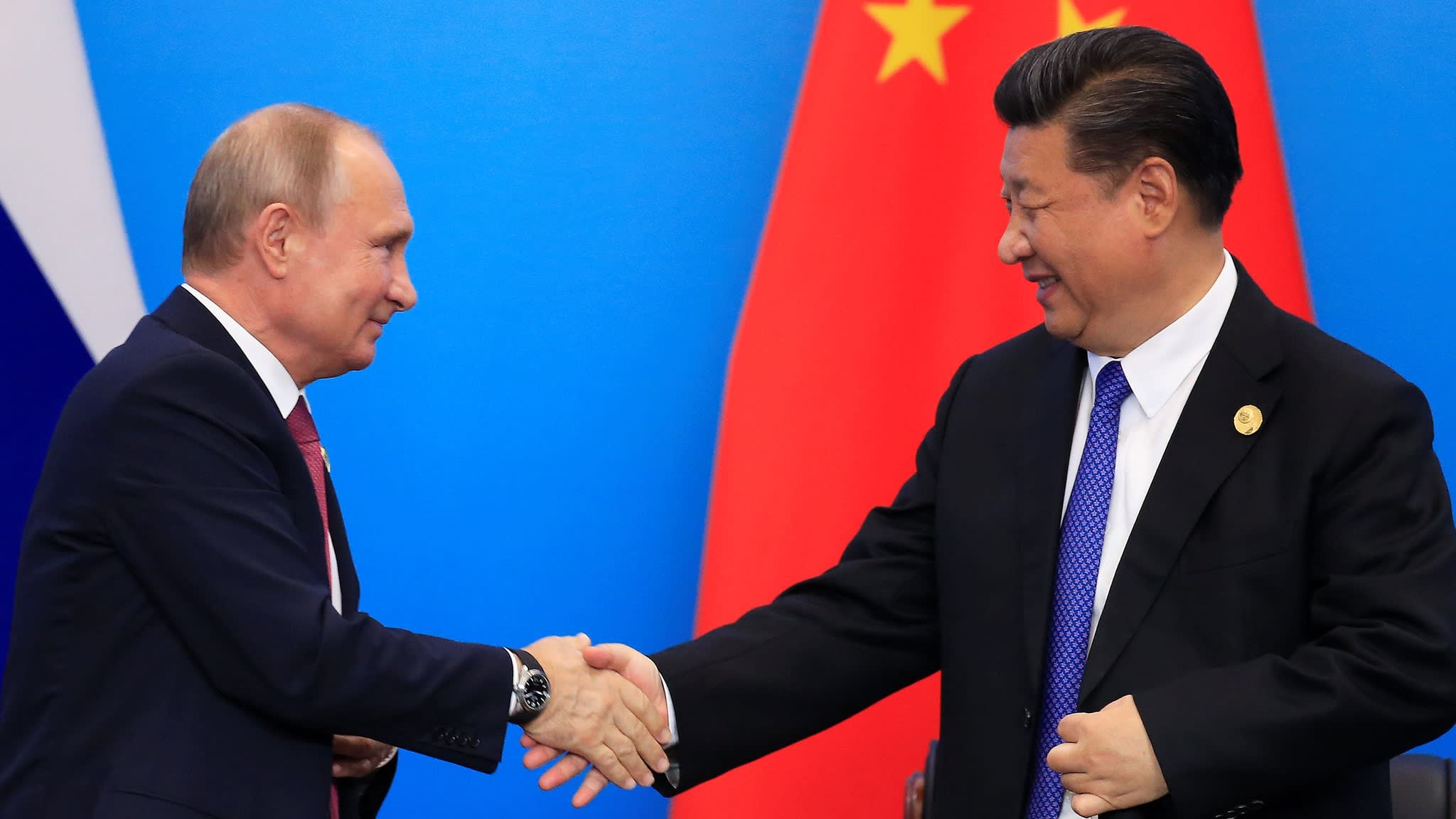
Putin and Xi agreeing to work closer together (largely against American global influence) –
June 10, 2019
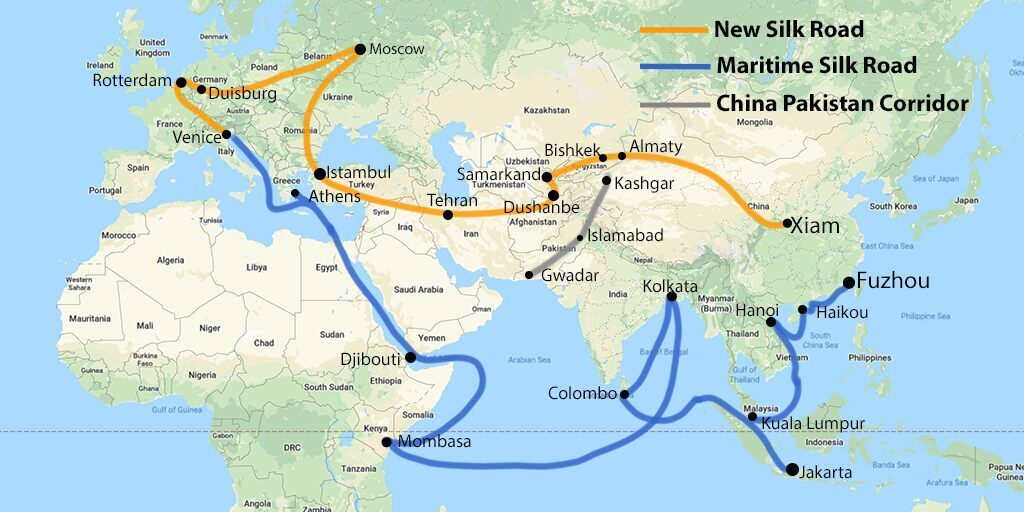
| China's
"One Belt, One Road" or Belt and Road Initiative (BRI), initiated back
in 2013, involves trillions of dollars in infrastructure development
assistance offered to countries struggling financially to meet their
economic challenges. This puts China in a very persuasive
position as to political as well as economic developments in the many
(100 or more?) countries receiving BRI ... and also China's Asian
Infrastructure Investment Bank (AIIB) assistance. |
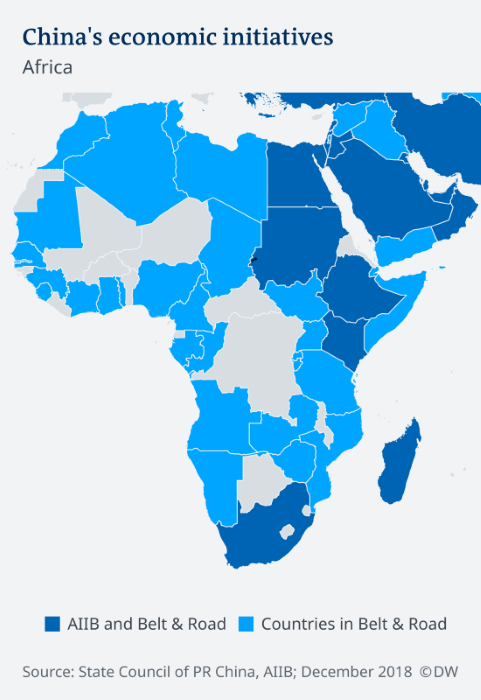
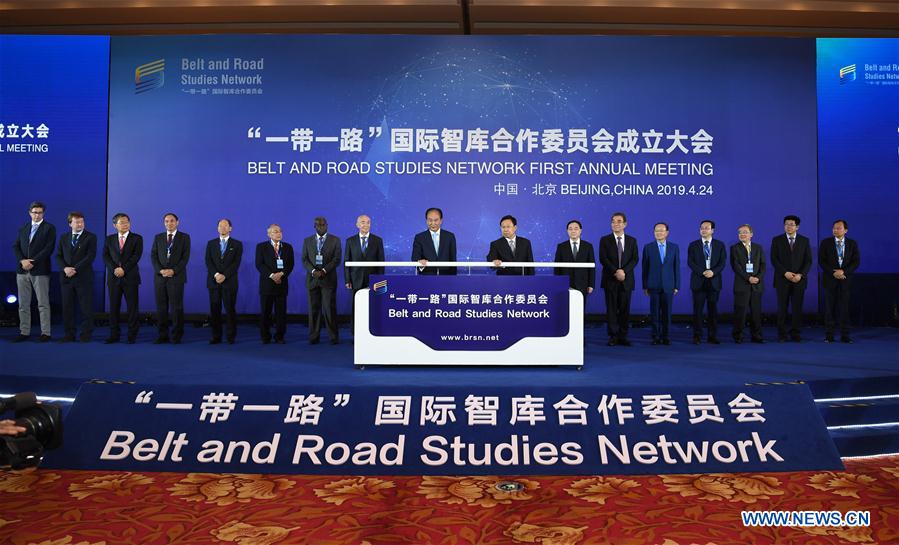
"Partners" in the Belt and Road program meet in Beijing – April 24, 2019 to initiate a
"Studies Network." The goal is a sharing of communications and ideas from universities
and research centers across the globe.
|
Another potential president-for-life, Russia's
Vladimir Putin, was slowly dragging Russia out of its 1990s collapse
into a Third-World status – in his quest to bring Russia back again as
a world power. Russia still had all the nuclear toys it needed (and
more) to make it a very dangerous player. A nd its well-developed
military machinery made it a country to be noticed again.
But most importantly, Putin was playing
the international game most skillfully, taking advantage especially of
America's many self-inflicted diplomatic and political wounds, and
also, like China, attempting to make Russia "useful" to other countries
around the world. Putin's game resembled somewhat Xi's game. In fact
the two declared something of a truce and began working together,
especially in the matter of dealing with superpower America.
Thus for instance Putin rushed in to aid Syrian President Assad after
Obama foolishly attempted to bring down Assad for engaging in illegal
weapons use against Syrian rebels. In the end Obama only helped to
deepen the Syrian agony – and the flight of millions of Syrian refugees
to the neighboring world.
Likewise Putin began to work more closely
with Iran, whose new treaty with America Trump rejected with the claim
that it was too one-sided of a deal. Thus both Russia and Iran moved
into Syria as Assad allies, giving these new Syrian allies vitally
strategic positions on the Eastern borders of the Mediterranean Sea,
something long sought by Russia – and even longer-sought by ancient
Persia, of which the Iranians are Persia's modern version.
Similarly, Putin (as well as Xi's
Chinese, plus the Iranians and North Koreans) rushed in to help
Socialist Maduro keep his dictatorial grip over a starving Venezuela,
at a time when America was attempting to isolate Maduro and see him
replaced by a pro-capitalist leader, Guaidó (thus reopening the
oil-rich country to such wealth as might feed its people once again).
And the Russians used their oil and gas
industries to put an energy-hungry but resource-poor Europe linked to,
and thus dependent on, Russian exports of these vital commodities. Even
America found itself helpless to assist its European allies in
retreating from this energy-dependent relationship with Russia,
especially in the matter of the gas that was piped directly and cheaply
from Russia to Germany. This Europe-Russia connection was all done in
the name of international peace and harmony. But in fact, it was also
done on the basis of old-fashioned power considerations. Putin was/is
no fool.
But most challenging to America is the
new relationship that Putin and Xi have been developing between Russia
and China, with the obvious intent of strengthening their positions in
opposition to the American position in international affairs. As trade
relations between China and America weaken, due to new restrictions
imposed by both America and China over the matter of trade and
intellectual property protection, the economic ties between Russia and
China have expanded considerably. Putin and Xi are working together on
the development of China's Maritime Silk Road across the newly open
waters of the Arctic above Siberia, at the same time Russia has been
moving to complete its Power of Siberia Pipeline so as to send a
much-increased volume of natural gas to a hungry Chinese market. The
two countries are also cooperating in the development of the new 5G
network, also linking Russia more closely to China, as well as in other
areas of infrastructure and technology development.
|
Putin is heading down the same road ... taking on absolute power
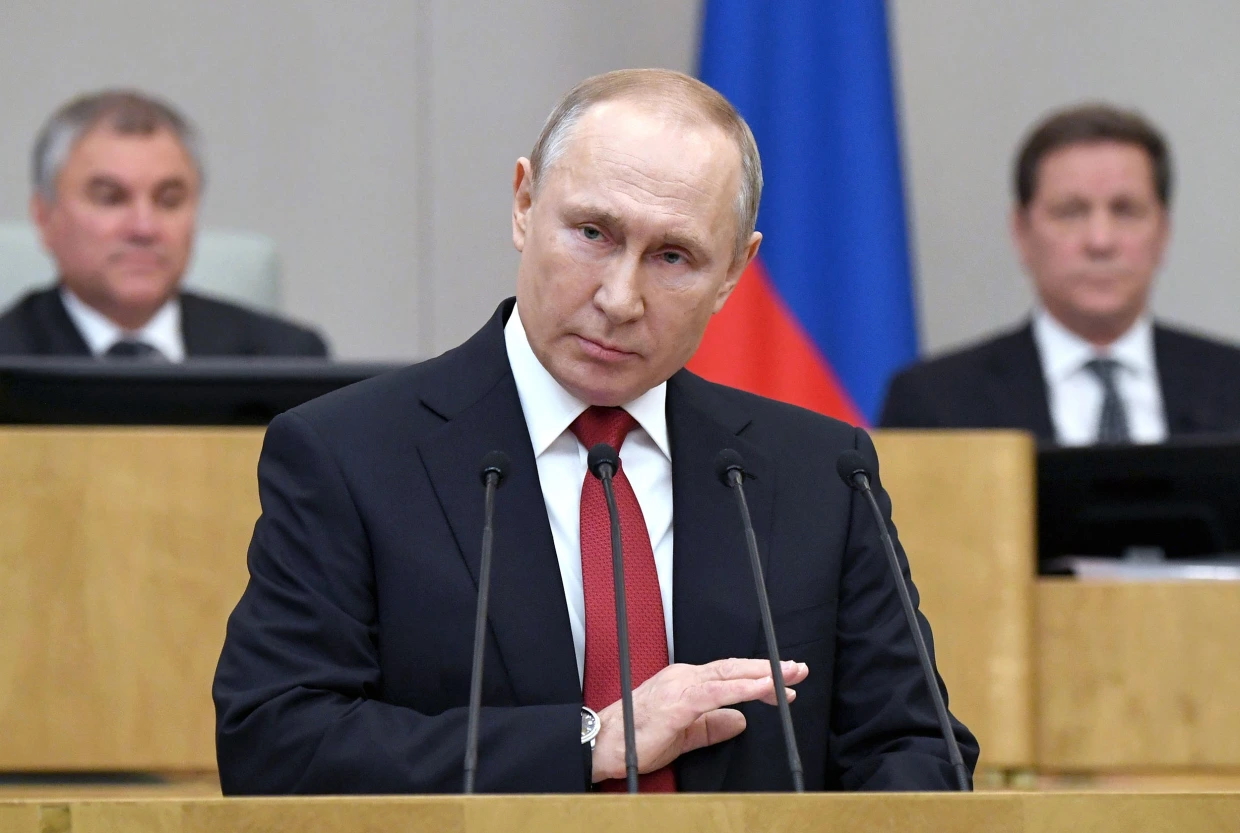
March 10, 2020 – Putin speaking at the Russian Duma
... as the Russian Constitution is being amended
to allow Putin to stay in power past his current term ending in 2024
... for an additional 12 years!
|
The Middle East has clearly moved away from
modeling itself on Western ways, to the place where it sees itself as
resuming the Mohammedan mission of forcibly bringing the world under
Islam. Europe has awakened to the realization that Islam has finally
achieved the goal of inserting itself into Western society in a way
that over the next few generations (through natural demographic
development as well as extensive mission work) the task of bringing
Europe to the "true faith" of Islam will finally be fulfilled. And
Europe has no moral-spiritual answer to this development. The
Christianity that wins hearts rather than kills opponents has fallen
asleep in Europe. Tragically, Secular Europe offers itself no cultural
defense any more (except some of the uglier forms of extreme
nationalism or Fascism).
A setback to this advancing Islamization
of Western civilization seemed to have occurred when finally the
Islamic State (or ISIS) and the Islamic Caliphate of al Baghdadi were
bombed into oblivion at the Syrian desert town of Baghuz in early
January of 2019. But the spirit that permitted the creation of ISIS and
the caliphate in the first place were by no means obliterated. That
spirit would simply find other ways of expressing itself (bombing
Western nightclubs or rock concert gatherings, for example). But Trump
at least let the world of jihadism know that America was going to be
much more proactive in its response to further attacks on Western
society.
Thus Trump's response to the
cultural-political disaster of Syria or Iraq was to gradually withdraw
the American presence there3 – while focusing more directly on Iran.
Trump saw Iran as the real challenge for America in the Middle East,
aggressive against America's allies in the Persian Gulf – and not to be
trusted at all not to find covert ways to develop the nuclear power
that it clearly wants in order to advance its crusade to bring down the
"Great Satan America." Thus in May of 2018, Trump ended Obama's "new
opening" to Iran, by abandoning the nuclear arms agreement that had
been worked out with Iran during the Obama administration. At the same
time, he clamped down on the Iranian oil export business, not only
boycotting Iranian oil but pressuring America's allies in Europe and
elsewhere to do the same.
It is clear that Iran has not wanted to
take on America directly (although some of the more radical elements in
Quds, Iran's Revolutionary Guard certainly have long wanted to do so),
but instead chose to hassle America's allies in order to embarrass and
weaken the American position in the vital oil regions of the Middle
East. Thus the Iranian cyber-attacks on the Saudi oil business and the
sabotage of oil tankers belonging to the emirates and the European oil
companies in the latter part of 2019. Also, Iran began to undertake
strategic military training programs in concert with Russia and China –
the adversary in question clearly being America and its NATO allies.
With this, Iran, Russia and China began to slowly bring a new version
of the Cold War back into play.
But Trump decided it was time to be more
proactive in taking on Iran. Just a few days after Iranian-supported
Shi'ite units invaded and burned a part of the American embassy in
Baghdad (following another more serious attack on an American military
compound), Trump responded (3 January 2020) by ordering the takedown of
General Qassem Soleimani, Iran's military strongman (head of Quds), the
individual who had directed those attacks on the Americans – as well as
on the neighboring Gulf states and Saudi Arabia. Soleimani was killed
by an American drone at the Baghdad airport – along with Jamal
Ibrahimi, a major Hezbollah leader, and several other individuals.
The American "peace" party among the
Congressional Democrats howled over the Soleimani takedown. But all
indications were that most Americans approved of the decision to be
tough instead of ever-appeasing of the Iranian regime – as had been the
case previously.
Iran, of course, issued promises of
massive retaliation in response to the attack. Maybe. But history would
show whether in the long run toughness or appeasement worked best in
keeping the Middle East safe for America and its allies.
In the meantime, Iran has begun to
undertake strategic military training programs in concert with Russia
and China – the adversary in question clearly being America and its
NATO allies. A new version of the Cold War has seemingly come back into
existence.
Trump felt that it was time to stop trying to do nation-building in
those two countries and leave them to their own development – as
long as they posed no direct threat to America. However, it was
this decision to withdraw from Syria that finally severed Trump's
stressful relationship with his Secretary of Defense, Mattis, who
disagreed strongly with the move.

March of 2017 ... ISIS is still very active in conducting and recording
the beheadings of various individuals
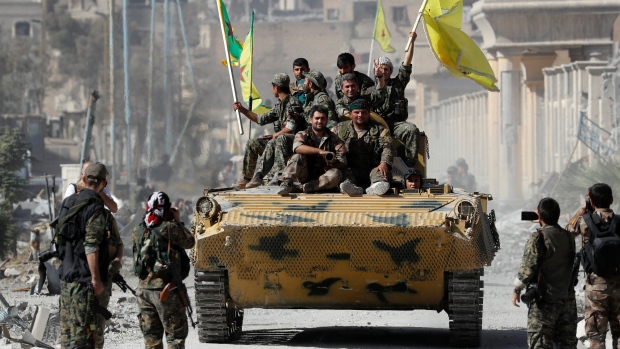
Finally in October of 2017 the last of ISIS fighter have been driven from Raqqa
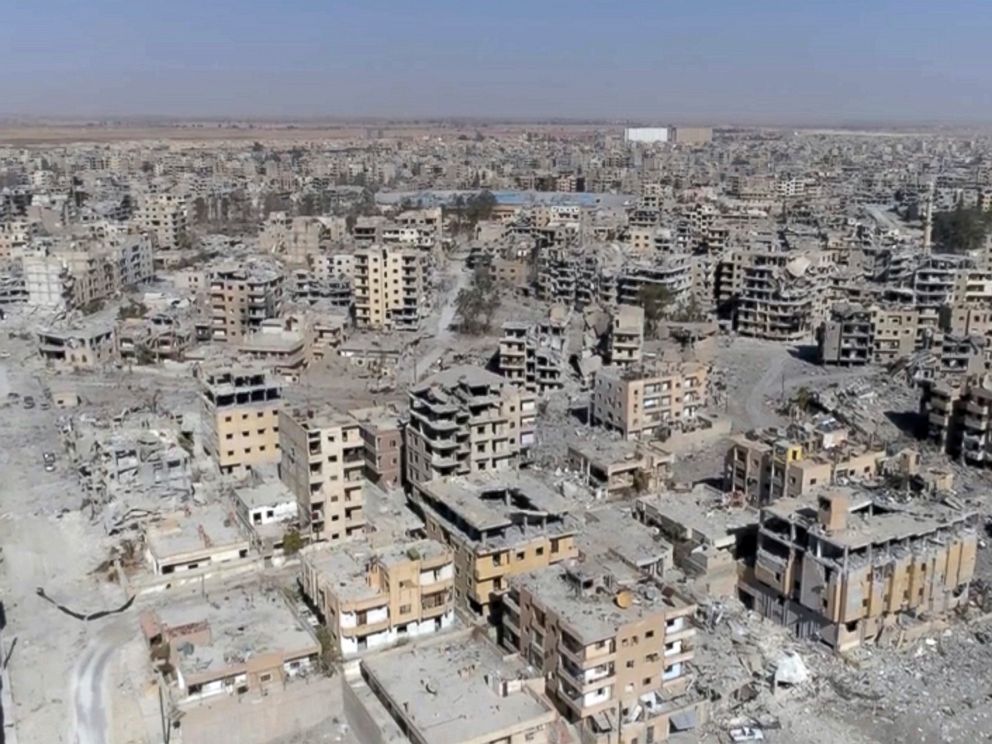
But
Raqqa itself is vastly damaged
THE BIZARRE WORLD OF KIM JUNG UN'S KOREA |
|
Then there was the matter of North Korea.
The relationship between Kim and Trump varied from friendly to very
bitter – pretty much based on the matter of exactly how willing North
Korea was in bringing nuclear and missile development under some kind
of limitation. Things got very intense when in 2017 Kim ordered the
testing of a number of intermediate-range missiles capable of carrying
nuclear warheads. Then in 2018 Kim initiated talks with Trump over the
suspending of nuclear and long-range missile tests. But the talks did
not go well and American (and international) economic sanctions against
North Korea remained strongly in place.
In late 2019 Kim issued attention-getting
threats to the world (America and its Asian allies principally) by
ordering a new round of testing of his missiles. Some saw this as a
probing of Trump's resolve – when Trump took no countering action after
Iran in June of 2019 shot down an American surveillance drone over the
Straits of Hormuz in the Persian Gulf. Certainly the takedown of
Soleimani, however, probably helped Kim get a better picture of Trump's
resolve when pushed more seriously.
However, whether a very dangerous North Korea would back down and try
again to work out some kind of working relationship with the larger
world (or not) remained/remains a matter of serious concern for
everyone.
|
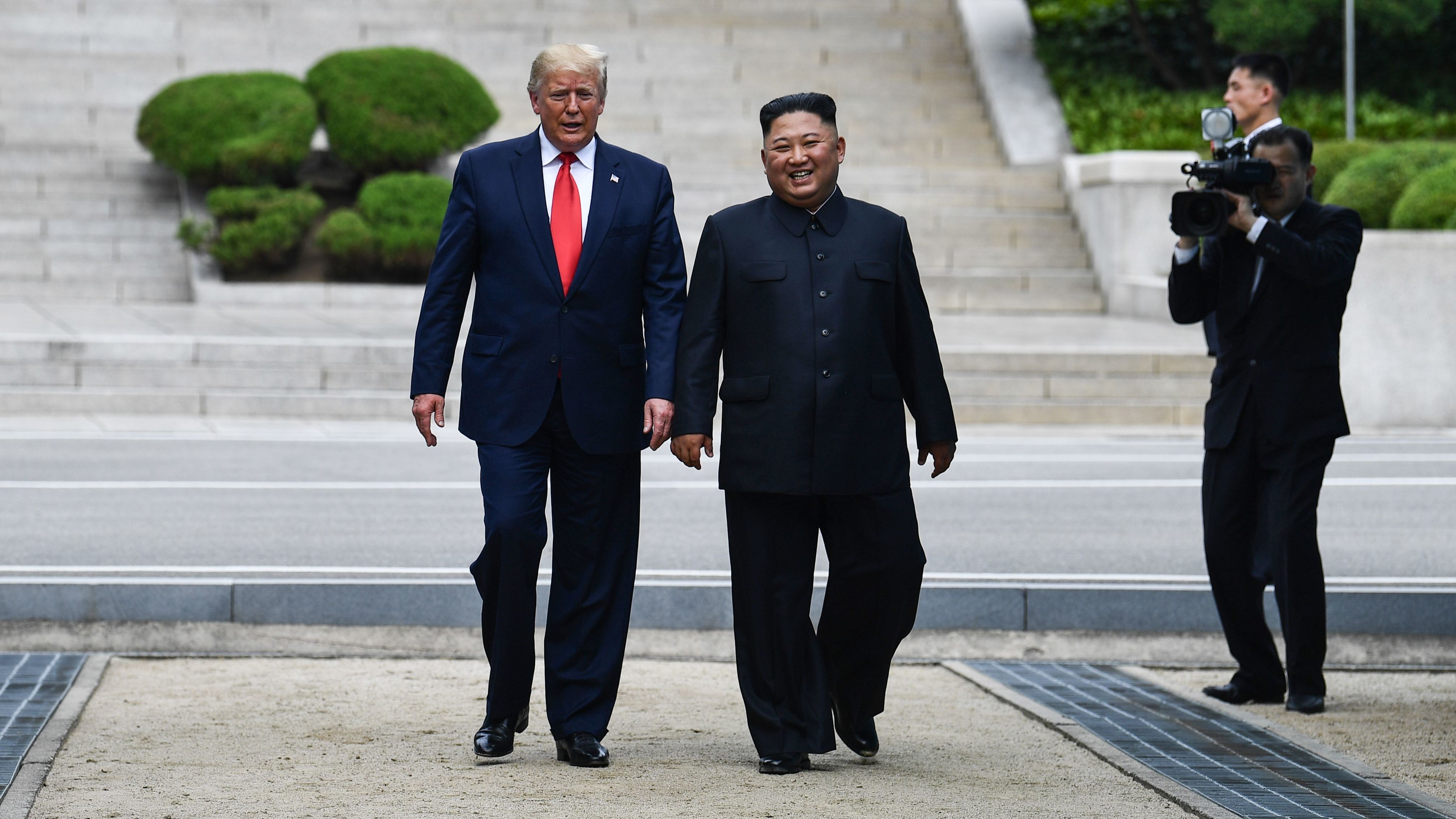
Trump meets Kim at the DMZ separating the two Koreas - June 2019
TRUMP'S RELATIONS WITH EUROPE |
|
At the same time, Trump's relations with Europe
seemed to have been as stormy as they had been with Congress. Even at
the announcement of his election, pro-Hillary and anti-Trump
demonstrations broke out across Europe (and elsewhere in the world),
obviously not spontaneous but showing signs of some considerable
organization and pre-event planning behind them. The political Left in
Europe, which is vastly more extensive than it is in America, was
dedicatedly anti-Trump from the very beginning of his campaign for the
presidency.
Trump's visits as American President to
Europe were accompanied by protests in the streets, again not exactly
spontaneous events. But in general, his frosty relations with European
political leaders (Germany's Merkel made no secret of how much she
detested Trump) warmed up a bit over time, although the Trump mouth
made that "thaw" all the more difficult to achieve – and then maintain.
His threat to pull out of NATO if
America's allies did not do more to support the military alliance did
not endear him much to those allies either! But in the end the pressure
did result in some of America's allies moving up to meet their full
financial responsibilities towards NATO.
|
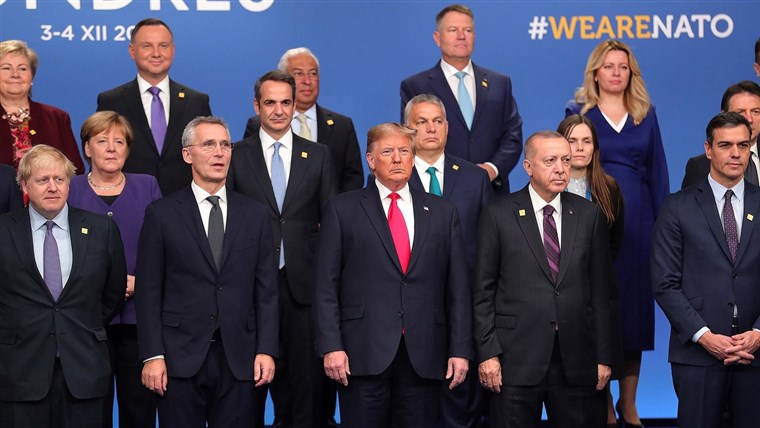
Trump and NATO leaders in the United Kingdom for a NATO conference – December 4, 2019. The press did what it could to portray Trump as the "man out" in the otherwise close circle of allies. Certainly there was stress over his insistence that others should pay their share of NATO's costs.

Go on to the next section: The American Crisis Deepens
 Miles
H. Hodges Miles
H. Hodges
| | | | | |


 Renegotiating NAFTA
Renegotiating NAFTA
 The bizarre world of Kim Jung Un's
The bizarre world of Kim Jung Un's



















